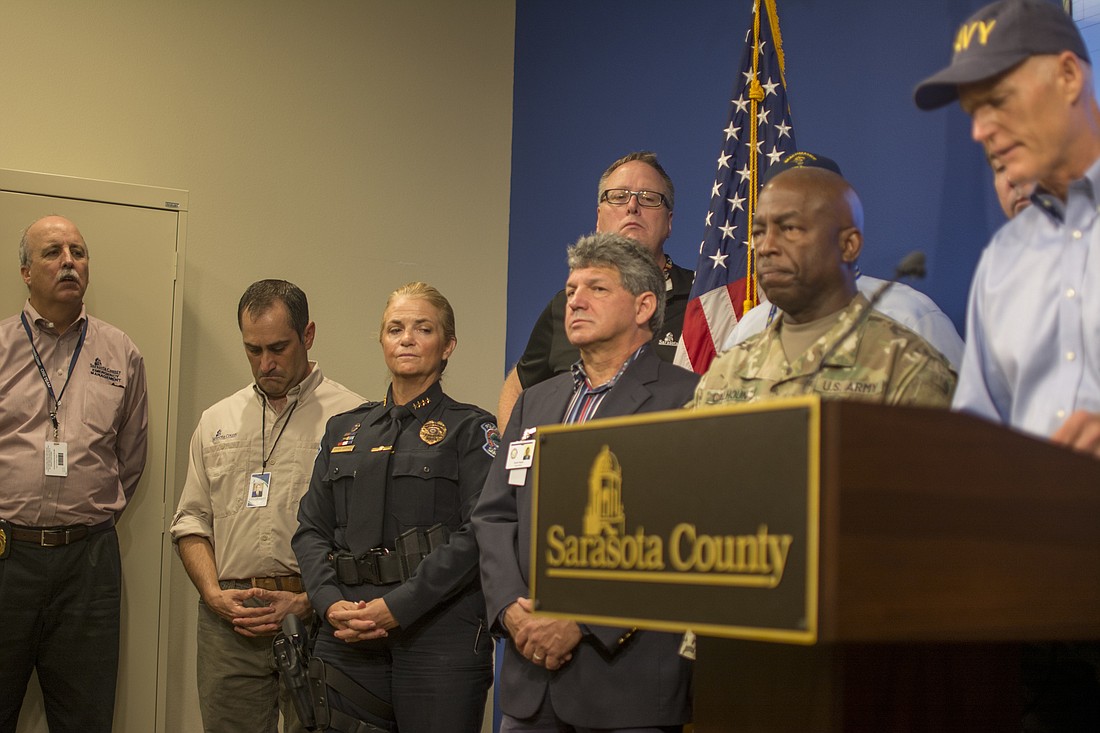- April 19, 2024
-
-
Loading

Loading

Before forecasts place Sarasota in the path of a hurricane — and even before the Atlantic hurricane season begins in June — Ed McCrane’s job is to prepare for disaster.
McCrane, the county’s emergency management chief, preaches the importance of planning ahead for a potential storm year-round. But the past two weeks, as the path of Hurricane Irma became a national news story, were a chance to see how those principles held up in a worst-case scenario.
The county had a large group of partners to work with — its four city governments, including the city of Sarasota, local law enforcement, the Sarasota County School District, state and federal officials, the National Guard and the American Red Cross.
As the forecast vacillated between problematic and disastrous, those groups stayed in constant contact with one another. By Sunday, nearly 19,000 people occupied Sarasota shelters. Fourteen shelters opened, with five filling to capacity.
It was the largest evacuation event in Sarasota County history. Put to a test the region had not dealt with in recent memory, McCrane gave both officials and residents high marks.
“I was very, very pleased and impressed with how everyone responded to it,” McCrane said.
At this point in the recovery process, the extent of the storm’s damage is still unknown. McCrane hopes to have an official cost estimate within the next few days, at which point local governments can seek state and federal aid.
Irma left Sarasota far from unscathed. In the city, there were 283 incidents deemed “urgent” that staff responded to, usually large trees blocking traffic or downed power lines. There are still impassable roads in the county, including near the beach on Casey Key.
And, three days after the storm, 66,800 Florida Power and Light customers still didn’t have power — and had little certainty about when their service would be restored.
At one point, about 218,000 of 260,000 Florida Power & Light Co. customers in Sarasota County were without power. In the city, 87% of residents lost power.
Once major debris was cleared from most roadways, restoring power throughout Sarasota became officials’ top priority. The outages have wide-reaching effects. Some traffic lights are still out — treat those intersections like four-way stops. Wastewater facilities are running on generators, so county officials are encouraging residents to minimize their water use to avoid any spillage.
The most significant issue, though, is avoiding any health and safety issues for the residents still without power.
“The lack of power causes a situation where there are people that don’t have air conditioning, and they’re dealing with the heat of the day,” McCrane said.
The county has set up 10 “comfort stations” to address this problem. McCrane said those sites would give residents a place to charge their phones, cool off and potentially get some water and food.
FPL, which has stationed workers and resources at the Sarasota Fairgrounds on Fruitville Road, said it hopes to restore power to all customers by Sept. 22. But city administrators hope power restoration will move faster. On Wednesday, City Manager Tom Barwin said he believes up to 95% of residents will have power by Saturday, Sept. 16.
Sarasota might have avoided the worst with Irma, but officials were preparing for a much bigger storm — which means they got a firsthand look at what worked and what didn’t as they mobilized for the hurricane.
By and large, they think they did a good job. Barwin, working his first major hurricane threat as city manager, was awed by the work of all parties involved.
“This state, its counties and cities are really way ahead of other places in pre-thinking their emergency response,” Barwin said.
But there’s room for improvement. McCrane said the scale of the evacuation, in particular, taught the county and school district some lessons on how to manage so many displaced people.
For example: Originally, the county designated some shelters pet-friendly and others off-limits for animals. As the storm drew closer, the county removed that designation, accepting pets at all locations.
“That resulted in a pretty big mess,” McCrane said. “Normally, the pet population is very controlled. These were just people with dogs inside buildings roaming around.”
In the future, McCrane said, the county would prepare to corral pets within specific areas to limit their effects. The county and school district also wanted to revisit their capacity figures for each shelter. McCrane believes the formula-derived numbers are too high.
“That’s on paper,” McCrane said. “When you really bring the people in and they have their suitcase and their sleeping bag and their air mattress and their cooler, they’re actually occupying more space.”
Barwin said the most important lesson he learned was the importance of communication — both between officials and with the public. He hopes there will be a better system for letting residents know when their power might be restored in the future. He was also disappointed that some shelters lost power and were without generators, and wanted leaders to plan for that issue.
McCrane said the experience should also be a lesson for residents: Don’t ignore warnings about being prepared for disasters. When a hurricane is imminent, water and supplies become scarce. Get ready ahead of time, McCrane encouraged — and start now.
“We need to keep in mind, this is still the peak of hurricane season,” McCrane said. “Hopefully, we’re good for another 10 years, but you never know. We can’t let our guard down.”